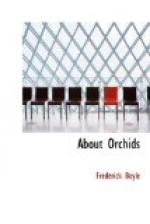Oncidium Lanceanum is, perhaps, the hottest of its genus. Those happy mortals who can grow it declare they have no trouble, but unless perfectly strong and healthy it gets “the spot,” and promptly goes to wreck. In the houses of the “New Plant and Bulb Company,” at Colchester—now extinct—Onc. Lanceanum flourished with a vigour almost embarrassing, putting forth such enormous leaves, as it hung close to the glass, as made blinds quite superfluous at midsummer. But this was an extraordinary case. Certainly it is a glorious spectacle in flower—yellow, barred with brown; the lip violet. The spikes last a month in full beauty—sometimes two.
An Oncidium which always commands attention from the public and grateful regard from the devotee is Onc. papilio. Its strange form fascinated the Duke of Devonshire, grandfather to the present, who was almost the first of our lordly amateurs, and tempted him to undertake the explorations which introduced so many fine plants to Europe.
The “Butterfly orchid” is so familiar that I do not pause to describe it. But imagine that most interesting flower all blue, instead of gold and brown! I have never been able to learn what was the foundation of the old belief in such a marvel. But the great Lindley went to his grave in unshaken confidence that a blue papilio exists. Once he thought he had a specimen; but it flowered, and his triumph had to be postponed. I myself heard of it two years back, and tried to cherish a belief that the news was true. A friend from Natal assured me that he had seen one on the table of the Director of the Gardens at Durban; but it proved to be one of those terrestrial orchids, so lovely and so tantalizing to us, with which South Africa abounds. Very slowly do we lengthen the catalogue of them in our houses. There are gardeners, such as Mr. Cook at Loughborough, who grow Disa grandiflora like a weed. Mr. Watson of Kew demonstrated that Disa racemosa will flourish under conditions easily secured. I had the good fortune to do as much for Disa Cooperi, though not by my own skill. One supreme little triumph is mine, however. In very early days, when animated with the courage of utter ignorance, I bought eight bulbs of Disa discolor, and flowered them, every one! No mortal in Europe had done it before, nor has any tried since, I charitably hope, for a more rubbishing bloom does not exist. But there it was—Ego feci! And the specimen in the Herbarium at Kew bears my name.
But legends should not be disregarded when it is certain that they reach us from a native source. Some of the most striking finds had been announced long since by observant savages. I have told the story of Phaloenopsis Sanderiana. It was a Zulu who put the discoverer of the new yellow Calla on the track. The blue Utricularia had been heard of and discredited long before it was found—Utricularias are not orchids indeed, but only botanists regard the distinction. The natives of Assam persistently assert that a bright yellow Cymbidium grows there, of supremest beauty, and we expect it to turn up one day; the Malagasy describe a scarlet one. But I am digressing.




